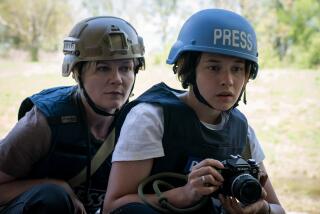‘Napalmed Girl’ on an Aid Mission
- Share via
As Congress and the White House begin to set priorities for next year’s budget, I ask policymakers in Washington not to forget the little girl in the famous photograph running down a road to escape napalm fire in Vietnam.
I am that girl, and my life changed forever that day.
I lost two cousins and many friends in that bombing 31 years ago. Sixty-five percent of my body was burned, and I had to endure many surgeries. For many years I also lost my ability to trust. I was filled with anger and bitterness toward my government, toward Americans, toward anyone who was “normal.”
My mother was caring throughout this ordeal, but she was also tough, telling me: “You have to realize the whole world is not going to pity you. You must make a change and get through this.”
I might not have made it if my mother had not taught me that lesson.
My journey into adulthood took me from Vietnam to Cuba and finally to Canada, where in 1992 I began to confront my past and make a new home and a new life for myself. Along the way, many doctors and caring individuals helped me, the first being Nick Ut, the Associated Press photographer who took the picture and rushed me to a hospital, saving my life.
I am happy now because I can experience love, peace and forgiveness. As a teenager, I thought I would never have children. I thought no one would ever love me or want to touch me. But now I am married and have two beautiful sons.
I was fortunate to have had so many help me, and I always wanted to use my experience to help others. That is why I started my foundation for children caught in war’s crossfire.
There are millions of children who have been traumatized by war. In some countries -- such as Afghanistan, Iraq, Liberia and the Democratic Republic of Congo -- it is rare to find a child not affected by war. Many children, hurt physically and psychologically, may never recover without extensive help.
Over the last century, the nature of war has changed dramatically. Today, 90% of war’s casualties are civilians, most of them women and children, according to the United Nations. During the 1990s, more than 2 million children were killed in armed conflicts. About 4 million more survived with physical mutilation, and more than 1 million were orphaned or separated from their families.
Humanitarian assistance to women and children caught in armed conflicts should be a top priority. But, unfortunately, this is not the case.
Though the United States for years has provided food, medical care and shelter to civilians affected by war, it has not done nearly enough to help protect women and children from the attendant horrors of war, such as rape and mutilation, prostitution, forced recruitment of children into the military, psychological trauma, family separation and physical abuse in refugee camps.
To help change this, I am working with Save the Children and dozens of other humanitarian organizations to persuade Congress to provide greater protections for women and children in war and conflict zones.
Last October, the Senate approved an amendment to the foreign operations spending bill that would require the U.S. government to develop an integrated strategy for addressing these issues. It also would prohibit federal aid to any humanitarian agency that had not adopted a code of conduct to protect beneficiaries from sexual exploitation and abuse.
The amendment is a good first step toward enacting the broader protections included in the Women and Children in Conflict Protection Act -- a bill introduced last spring that would provide $45 million in new funding to help women and children suffering from the ravages of war and conflict. On behalf of millions of war victims like myself worldwide, I ask the administration and Congress to support the entire protection act.
The legislation would not end wars or the terrible suffering of so many women and children, but at least it would recognize that they should come first, not last, when the United States responds to war and its terrible aftermath.
More to Read
Get the L.A. Times Politics newsletter
Deeply reported insights into legislation, politics and policy from Sacramento, Washington and beyond. In your inbox twice per week.
You may occasionally receive promotional content from the Los Angeles Times.










